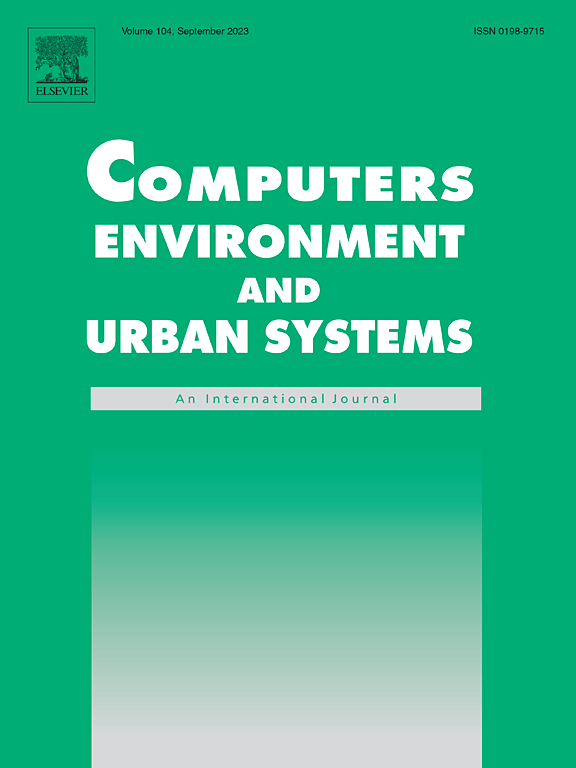Identifying street multi-activity potential (SMAP) and local networks with MLLMs and multi-view graph clustering
IF 8.3
1区 地球科学
Q1 ENVIRONMENTAL STUDIES
Computers Environment and Urban Systems
Pub Date : 2025-09-02
DOI:10.1016/j.compenvurbsys.2025.102350
引用次数: 0
Abstract
Streets are essential public spaces hosting a variety of social, cultural, and economic activities that collectively form urban vitality. However, due to limitations in research methodology and data, existing studies often oversimplify street activities by focusing solely on pedestrian flows. This study introduces a novel approach using Multimodal Large Language Models (MLLMs) and multi-view graph-based community detection to systematically evaluate street multi-activity potential (SMAP). Utilizing diverse urban data, we quantified the SMAP based on six common pedestrian activities (sitting, standing, walking, jogging, exercising, and street vending) in Beijing's central urban area. Results reveal significant spatial disparities in the suitability scores of different activity types, challenging the conventional reliance on walking as a proxy for street activities. By applying community detection algorithm with multi-view graph fusion and reinforcement learning, we identified 245 SMAP areas and uncovered their underlying spatial network patterns in Beijing. Assessment of SMAP areas' total potential and diversity of potential reveals the complex relationship between the two dimensions. By further identifying high total potential SMAP areas with varied levels of diversity, we discovered their distinct patterns in semantic features and spatial distributions. Overall, this study develops a novel and scalable framework for evaluating street spaces and observing their potential for diverse activities, which will guide future planning to support activity diversity and enhance urban vitality.
利用mllm和多视图图聚类识别街道多活动潜力(SMAP)和本地网络
街道是举办各种社会、文化和经济活动的重要公共空间,共同形成城市活力。然而,由于研究方法和数据的限制,现有的研究往往过于简化街道活动,只关注行人流量。本文介绍了一种利用多模态大语言模型(MLLMs)和基于多视图图的社区检测来系统评估街道多活动潜力(SMAP)的新方法。利用不同的城市数据,我们基于北京中心城区六种常见的步行活动(坐、站、走、慢跑、锻炼和街头贩卖)对SMAP进行了量化。结果显示,不同活动类型的适宜性得分存在显著的空间差异,挑战了传统的以步行为代表的街头活动。采用基于多视图图融合和强化学习的社区检测算法,对北京市245个SMAP区域进行了识别,揭示了其潜在的空间网络格局。SMAP地区的总潜力和潜力多样性评价揭示了两者之间的复杂关系。通过进一步识别具有不同多样性水平的高总潜力SMAP区域,我们发现了它们在语义特征和空间分布上的独特模式。总体而言,本研究开发了一个新颖的可扩展框架,用于评估街道空间并观察其多样化活动的潜力,这将指导未来的规划,以支持活动多样性并增强城市活力。
本文章由计算机程序翻译,如有差异,请以英文原文为准。
求助全文
约1分钟内获得全文
求助全文
来源期刊

Computers Environment and Urban Systems
Multiple-
CiteScore
13.30
自引率
7.40%
发文量
111
审稿时长
32 days
期刊介绍:
Computers, Environment and Urban Systemsis an interdisciplinary journal publishing cutting-edge and innovative computer-based research on environmental and urban systems, that privileges the geospatial perspective. The journal welcomes original high quality scholarship of a theoretical, applied or technological nature, and provides a stimulating presentation of perspectives, research developments, overviews of important new technologies and uses of major computational, information-based, and visualization innovations. Applied and theoretical contributions demonstrate the scope of computer-based analysis fostering a better understanding of environmental and urban systems, their spatial scope and their dynamics.
 求助内容:
求助内容: 应助结果提醒方式:
应助结果提醒方式:


